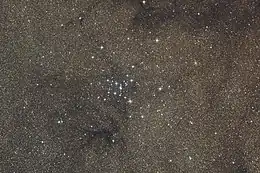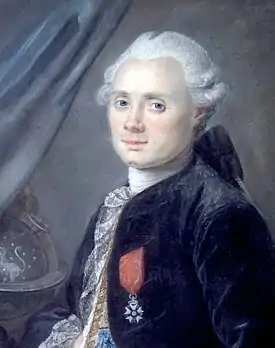Messier 7
Messier 7 or M7, also designated NGC 6475 and sometimes known as the Ptolemy Cluster,[4] is an open cluster of stars in the constellation of Scorpius. The cluster is easily detectable with the naked eye, close to the "stinger" of Scorpius. With a declination of −34.8°, it is the southernmost Messier object.
| Messier 7 | |
|---|---|
 | |
| Observation data (J2000.0 epoch) | |
| Constellation | Scorpius |
| Right ascension | 17h 53m 51.2s[1] |
| Declination | –34° 47′ 34″[1] |
| Distance | 980 ± 33 ly (300 ± 10 pc)[2] |
| Apparent magnitude (V) | 3.3 |
| Apparent dimensions (V) | 80.0′ |
| Physical characteristics | |
| Mass | 735[3] M☉ |
| Radius | 25 ly |
| Estimated age | 200 Myr[2] |
| Other designations | Ptolemy Cluster, M7, NGC 6475, Cr 354 |

M7 has been known since antiquity; it was first recorded by the 2nd-century Greek-Roman astronomer Ptolemy, who described it as a nebula in 130 AD.[5] Italian astronomer Giovanni Batista Hodierna observed it before 1654 and counted 30 stars in it. In 1764, French astronomer Charles Messier catalogued the cluster as the seventh member in his list of comet-like objects. English astronomer John Herschel described it as "coarsely scattered clusters of stars".[4]
Telescopic observations of the cluster reveal about 80 stars within a field of view of 1.3° across. At the cluster's estimated distance of 980 light years this corresponds to an actual diameter of 25 light years. The tidal radius of the cluster is 40.1 ly (12.3 pc) and it has a combined mass of about 735 times the mass of the Sun.[3] The age of the cluster is around 200[2] million years while the brightest member star is of magnitude 5.6. In terms of composition, the cluster contains a similar abundance of elements other than hydrogen and helium as the Sun.[2]
On August 29, 2006, Messier 7 was used for first light image of the Long Range Reconnaissance Imager (LORRI) telescope on the Pluto-bound New Horizons spacecraft.[6]
References
- "MESSIER 007", NASA/IPAC Extragalactic Database, NASA, retrieved 2012-04-19
- Villanova, S.; Carraro, G.; Saviane, I. (September 2009), "A spectroscopic study of the open cluster NGC 6475 (M 7). Chemical abundances from stars in the range Teff = 4500-10 000 K", Astronomy and Astrophysics, 504 (3): 845–852, arXiv:0906.4330, Bibcode:2009A&A...504..845V, doi:10.1051/0004-6361/200811507
- Piskunov, A. E.; et al. (January 2008), "Tidal radii and masses of open clusters", Astronomy and Astrophysics, 477 (1): 165–172, Bibcode:2008A&A...477..165P, doi:10.1051/0004-6361:20078525
- Gendler, Robert; Christensen, Lars Lindberg; Malin, David (2011), Treasures of the Southern Sky: A Photographic Anthology, Springer, p. 139, ISBN 978-1461406273
- Jones, Kenneth Glyn (1991), Messier's Nebulae and Star Clusters, The Practical astronomy handbook series (2ns ed.), Cambridge University Press, p. 1, ISBN 978-0521370790
- "LORRI's First Light1". pluto.jhuapl.edu. Retrieved 2018-10-24.
External links
| Wikimedia Commons has media related to Messier 7. |
- Messier 7, SEDS Messier pages
- Messier 7 on WikiSky: DSS2, SDSS, GALEX, IRAS, Hydrogen α, X-Ray, Astrophoto, Sky Map, Articles and images
- NASA Astronomy Picture of the Day: M7: Open Star Cluster in Scorpius (12 September 2012)
- New Horizons probe captures M7
- NASA Astronomy Picture of the Day: M7: Open Star Cluster in Scorpius (13 July 2016)

